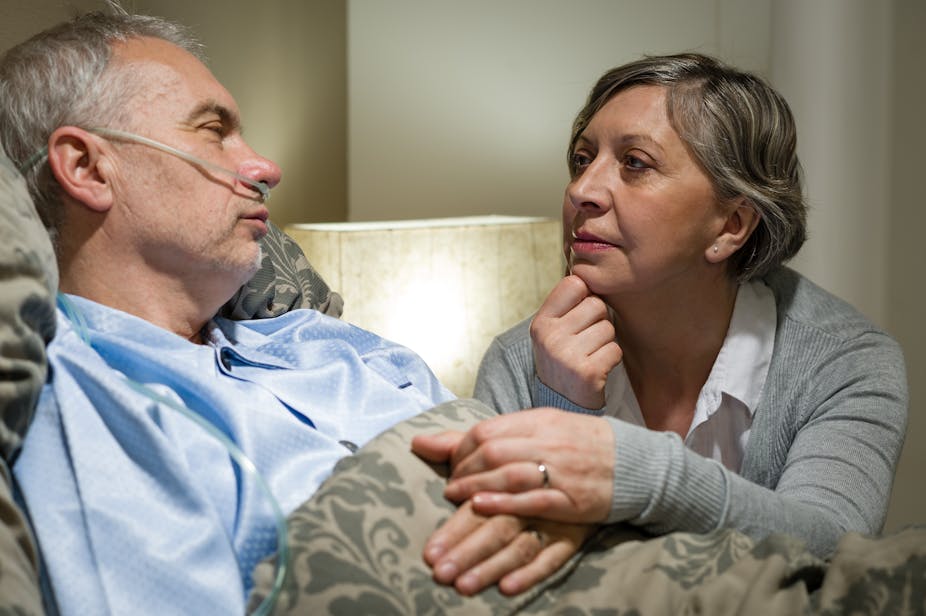Every year around half a million people die in England. The success of medicine over the past decades has led to a sustained rise in the average human life expectancy: a third of children born today will live to be 100 years old. However, it does not follow that fewer people are dying. In fact, the annual number of deaths in England has begun to rise and is projected to continue to do so for at least the next 20 years.
How will you die?
What will the trajectory of our final deterioration be like? For around a fifth of us, our deaths will be sudden, and unpredictable – from a large stroke or an accident, for example. A further fifth of us are likely to die from cancer, and will live with relatively good physical function until quite close to death, when there is usually a relatively linear deterioration over weeks. The rest – the majority of us – will live with and die from chronic medical problems such as heart failure, kidney failure and dementia, and our final days, weeks and months will be characterised by relapses and remissions against a background of a slowly progressive deterioration in physical function.
Palliative care
Palliative care is a philosophy of care for people who are approaching the ends of their lives, where the goal is to improve the patient’s comfort and quality of life, rather than trying to extend or increase its quantity. The word palliative comes from the Latin palliare meaning “to cloak” and palliative care focuses on finding out what the worst problems for the patient and their family are, and to then improve them.
Part of the focus of palliative care is on relieving physical symptoms, which are common (though not universal) in people who are dying. More than a third of dying people will experience pain. Effective treatment depends on identifying the likely cause of it. For many types of pain, opioids such as morphine sulphate are the mainstay of treatment. It is important for patients to realise that taking opioids in the right doses for their pain will not cause them to become addicted, or to die more quickly.
A principle of palliative care is that only medication which has the aim of improving comfort is given to people who are thought to be dying. Drugs with longer-term benefits (such as cholesterol-lowering drugs) are usually stopped. Medicines can be given by mouth, or in other forms such as injections or infusions under the skin if the patient finds swallowing difficult.
While assessment and treatment of physical symptoms is a large part of palliative care, it is also essential to address psychological, social and spiritual needs. Cicely Saunders, who founded the modern palliative care movement in the 1960s, defined the concept of Total Pain, suffering that encompasses not just physical but also social, psychological and spiritual dimensions. Therefore in order to control pain in the dying it is necessary to explore these dimensions. Questions such as: “How do you make sense of the future?”, “Where do you find your strength?” and: “What is most important to you?” are often useful.
When do you know it’s the end?
How do we know when to “switch” to palliative care? How do we know when a person is dying? The last weeks of life for most people are characterised by a progressive physical decline, frailty, lethargy, worsening mobility, reduced oral intake, and little or no response to medical interventions. However, these changes can be subtle. In people with frailty and dementia, the dying phase can be difficult to distinguish because patients can live for a long time with a very poor level of function.
It is therefore important to provide palliative care in parallel with, rather than in series with, other medical care. This will include having sensitive conversations with the patient and their carers about their wishes and preferences for the future, in anticipation of their deterioration. For example, many patients would prefer to die at home rather than in hospital and it is essential to explore such preferences while the patient remains well enough to travel.
These conversations can be hard for healthcare professionals, whose training equips them for saving lives, and for whom death is often viewed as failure. Both the doctor and the patient may view talking about death as an admission of defeat. But however uncomfortable these conversations are, the danger of avoiding them is a medicalised death, with more suffering for the patient, and more distress in bereavement for their carers. As Cicely Saunders said: “How we die remains in the memory of those who live on.”

